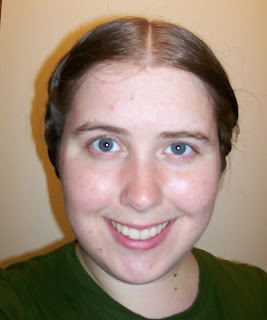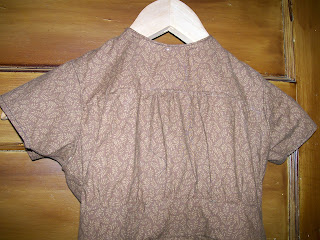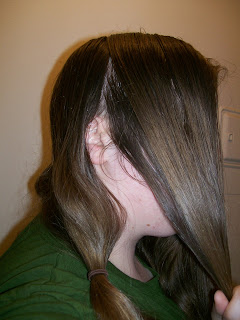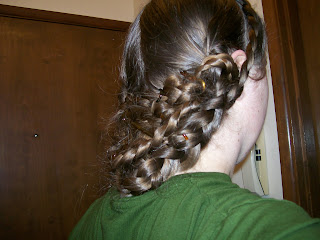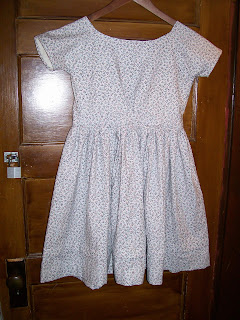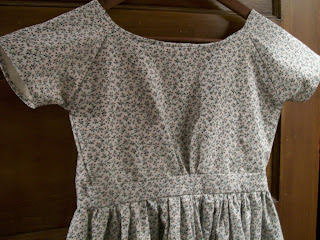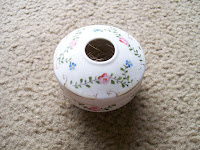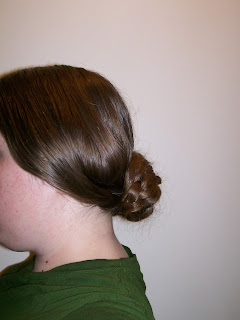Working on a cap for a friend who does an ACW nurse impression. She needs something to cover a a hair 'transition', but also lightweight to avoid heat problems.
A cap, white and plain, seem to be synonymous with "nurse". Both in fiction and non, descriptions of nurses frequently refer to their white caps (and aprons, and collars and cuffs), and plain dresses.
"While linen collars--white aprons--and a plain white cap--compose their very homely but convenient attire." -
The Southern Literary Messenger, 1864 (description of Roman Catholic lay volunteer nurses)
"... she should wear a common dress and linen cap, and be no way remarkable to the eye of the patient..." -
Sowing and Reaping, 1867
"Their dress is simple, black, with white collars and undersleeves, and, when in full dress, a Swiss muslin cap."-
The Employment of Women, 1863
"She put on the coarsest clothes to be bought for money, a light cap... and went into the largest hospital in Washington as a nurse..." -"The Stolen Bond" in
Peterson's Magazine, 1866
"I shall go as a volunteer nurse. In Baltimore the nurses have a uniform, -- a black or brown merino dress, tight sleeves, no hoops, tiny linen collar and cuffs, and a white tarleton cap."
Anecdotes, Poetry, and Incidents of the War, 1866
German Protestant
"deaconesses" who work as nurses wear "...a gown of blue and a white collar and cap."
"Her dress was plain black from throat to heel, with a skull cap of white, like a Moravian sister." -
The Fortnightly Review, 1867
"For her to be a soldier's nurse meant something very different from wearing a white apron, a white cap, sitting by a moaning soldier's bed, looking pretty." -
Women's Work in the Civil War, 1867
"He rejoins the army, while she follows as a nurse to 'St. Marc's, a military hospital, and dons a muslin cap and other unbecoming articles of attire, and devotes herself to the saintly work of alleviating human suffering." -
The Knickerbocker, 1864
The only color given is white; the materials include linen and fine cottons ("muslin", "tarletan"); the caps are "plain", or even "unbecoming". Such a ubiquitous but non-decorative article must serve some sort of practical purpose--keeping the hair clean, out of the way, or concealed. The white cotton/linen ensures easy washing.
Of course, searching for cap patterns in the magazine of the '60's can get very trying. There are plenty of mentions of caps, descriptions of them, and occasionally even an engraving. Patterns? Between 1855-1865, I've found three, all night-caps. The best source I know of for cap patterns is the 1840
Workwoman's Guide, which has pages upon pages of the things, for all possible occasions. Unfortunately, twenty years have elapsed between the publication of that book and the outbreak of the war, including radical changes in hair-dressing and cap-wearing.
My usual go-to in such cases is the
The Ladies' Self-Instructor in Millinery and Mantua-Making (1853). Though less comprehensive than the WWG, it's closer to my target dates. Unfortunately, all is has to say about caps is that there are many different styles and you should pick one which suits you.
If pictures are being provided, but not diagrams, then the magazines of the early 1860s are assuming that ladies either already know how to make up caps (and thus only need inspiration) or are hiring someone who does. The only dissemination of such information that I can find is in earlier sources like the WWG, and an adult woman of the early '60s would be familiar with the styles/techniques therein from childhood...but it's still a bit of a stretch for me.
One thing that the WWG does mention, though, is that certain patterns might be used to make nightcaps, or day caps for servants/poor persons. If this holds true to the '60s--and as far as I can tell night caps, servant's day caps, and nurses' caps are functional head-coverings meant to shield/conceal the hair more than adorn it--than those three night-cap pattern are probably my best bet.
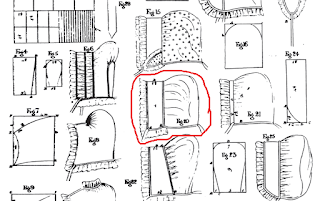 |
(No. 20): "This shape is particularly suitable for day-caps for young
servants, or night-caps for any age or station."
From The Workwoman's Guide. Plate 9; instructions on page 66. |
Option 1:
Peterson's Magazine, 1859. A night-cap from their series on home-sewing:
 |
| Night-cap. Peterson's, March 1859. Page 242. |
 |
| Diagram of Night-cap. |
Number 2: There's another night cap from
Peterson's ('61) that's a bit more "novel" in it's design:
Number 3: An 1859 pattern from the
The Young Lady's Book. This one is also made up in two pieces, with a straight front piece (brim) and mailbox-shaped crown.
Of the three, I prefer the definition of the first and last pattern; made up plain, I don't think the round crown will look as becoming as it would trimmed. The batiste remnants available for the project make number three look like the best bet, as it doesn't need to be cut in a single piece.

